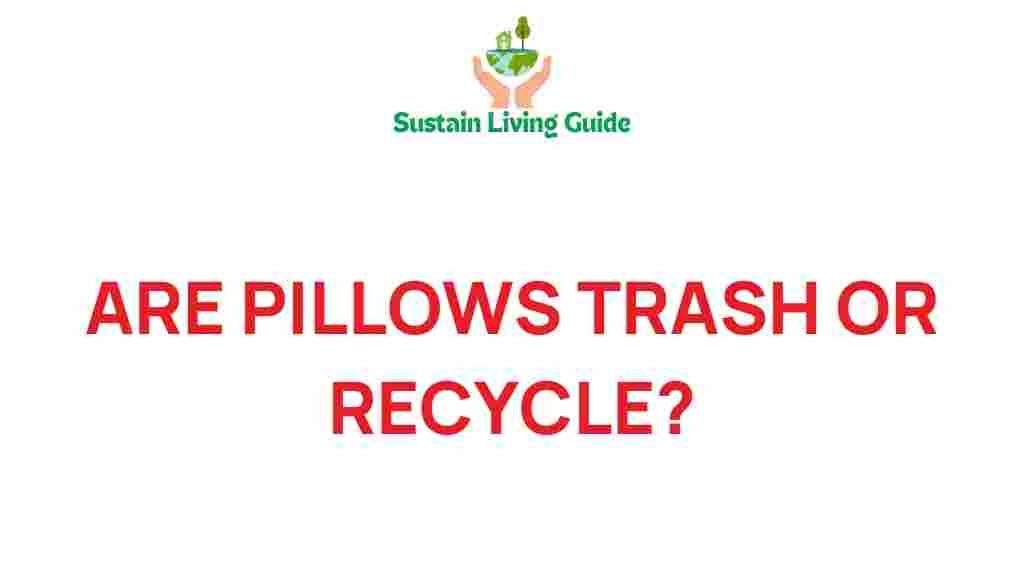Are Pillows Trash or Recycling Gold?
Pillows are an essential part of our sleep routine, offering comfort and support during the night. However, when it’s time to replace them, many people find themselves asking: Are pillows trash or recycling gold? This question is particularly relevant as we grow more conscious of our environmental impact. In this article, we will unpack the dilemma surrounding the disposal of pillows, exploring whether they belong in the trash bin or if they can be recycled or repurposed. We’ll also provide tips for proper pillow disposal and alternatives that can help you contribute to a more sustainable future.
Understanding Pillow Composition
To determine whether pillows are trash or recycling gold, we first need to understand what they are made of. The composition of pillows varies widely and includes the following materials:
- Memory Foam: Known for its contouring properties, memory foam pillows are made from polyurethane and can take a long time to decompose.
- Down and Feather: These natural materials are soft and provide excellent insulation but can also contribute to waste when disposed of improperly.
- Synthetic Fill: Polyester and other synthetic fibers are commonly used in budget-friendly pillows, but they are not biodegradable.
- Latex: Made from rubber tree sap, latex pillows are more eco-friendly as they are biodegradable, but they still require proper disposal.
The Lifecycle of Pillows
Pillows generally have a lifespan of about 1 to 2 years, depending on their material and usage. Over time, they lose their shape and support, leading to discomfort and potential health issues such as neck pain or allergies. When it’s time to replace your pillows, consider the following:
- Check for visible wear and tear.
- Perform the “fold test” – if the pillow doesn’t bounce back when folded, it’s time to let it go.
- Look for stains or odors that can’t be cleaned.
Is It Time to Dispose of Your Pillows?
Before deciding whether to throw your pillows in the trash or recycle them, here are some factors to consider:
- Condition: If the pillow is still in decent shape, consider donating it to a local shelter or animal rescue.
- Material: The type of material can dictate whether it can be recycled. Synthetic materials are often not accepted in recycling programs.
- Local Regulations: Research your local waste management rules regarding the disposal of pillows.
Donation Options for Old Pillows
If your pillows are in good condition, consider donating them. Here are some options to explore:
- Animal Shelters: Many shelters accept old pillows for bedding.
- Homeless Shelters: Some local shelters may be willing to take your gently used pillows.
- Churches or Community Centers: These places often have programs for those in need and might accept your pillows.
The Recycling Process for Pillows
Recycling pillows can be a bit complicated due to their mixed materials. However, here’s a step-by-step process to follow:
Step 1: Check for Recycling Facilities
Before attempting to recycle your pillows, check if there are any local recycling facilities that accept them. Some specialized centers can handle certain materials. You can check resources like Earth911 for recycling options in your area.
Step 2: Separate Materials
If you can, separate the pillow into its components. For example:
- Memory Foam: This may be recyclable at specific centers.
- Down and Feather: These can sometimes be repurposed for insulation products.
- Synthetic Fill: Generally not recyclable, but check local guidelines.
Step 3: Dispose of Non-Recyclable Components
If certain parts of your pillow cannot be recycled, you may have to dispose of them in the trash. Make sure to follow your local waste disposal regulations.
Troubleshooting Common Pillow Disposal Issues
Here are some common issues you may encounter when disposing of pillows and how to troubleshoot them:
Issue 1: Local Recycling Programs Don’t Accept Pillows
If you find that your local recycling program does not accept pillows, consider checking with larger waste management companies or looking for specialty recycling centers nearby.
Issue 2: Pillow Materials Are Mixed
Many pillows are made from a combination of materials, making them challenging to recycle. In this case, focus on repurposing or donating the items that can be reused.
Issue 3: Allergies or Odors
If your pillows have developed an odor or allergens, it may be best to dispose of them in the trash. Cleaning them thoroughly before donation can help, but if the smell persists, it’s safer to discard them.
Alternative Uses for Old Pillows
Before tossing your old pillows, consider alternative uses that can extend their life and reduce waste:
- Pillow Covers: Repurpose old pillows by sewing them into cushion covers for chairs or outdoor seating.
- Pet Beds: Use old pillows as comfortable bedding for your pets.
- Stuffing: Cut open old pillows and use the filling for DIY projects like stuffed toys or cushions.
Conclusion: Making Informed Choices About Pillows
In the debate of whether pillows are trash or recycling gold, the answer largely depends on their condition, material, and your local recycling options. While some pillows may end up in the trash, many can find a second life through donation or repurposing. By being conscious of how we dispose of or recycle pillows, we can contribute to a healthier planet. Remember, every small action counts, and making informed choices can lead to significant environmental benefits.
For more information about pillow recycling and responsible disposal methods, you can visit Earth911 for resources tailored to your location.
Ready to declutter your home? Explore options for donating your old pillows or transforming them into something new today!
This article is in the category Waste and created by SustainLivingGuide Team
